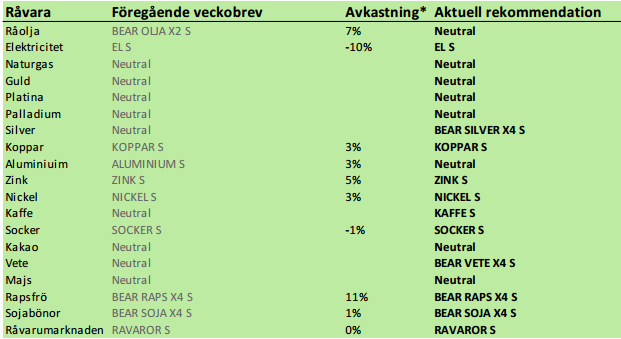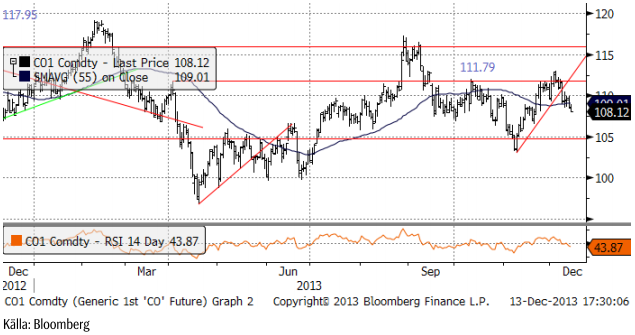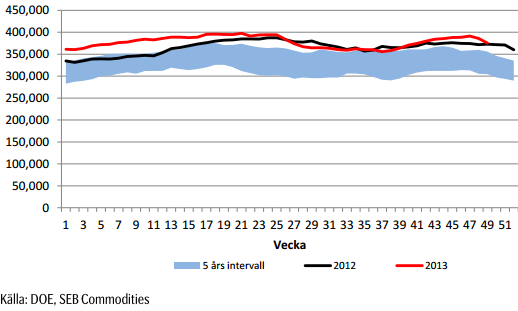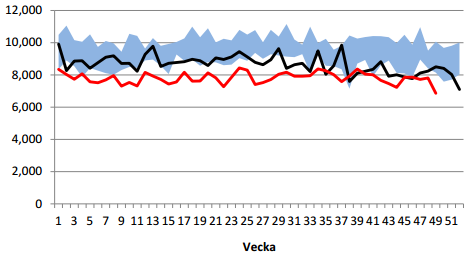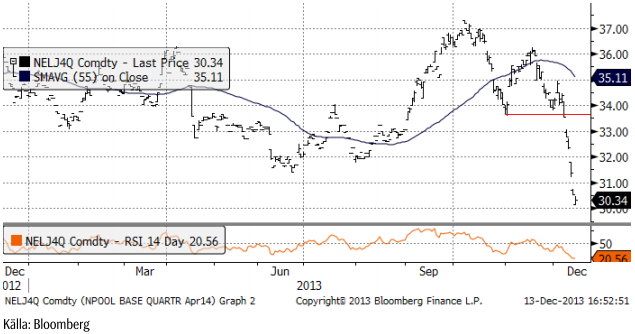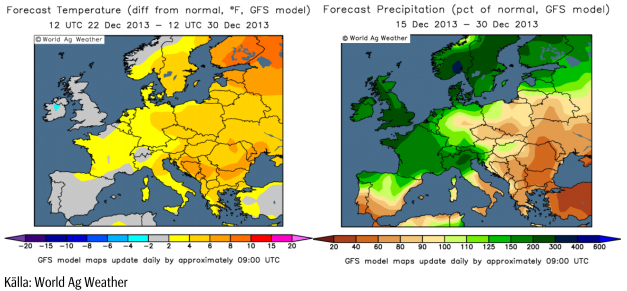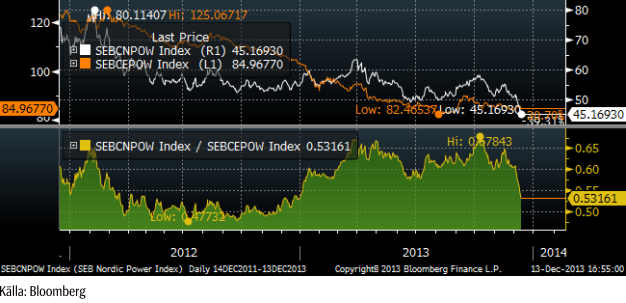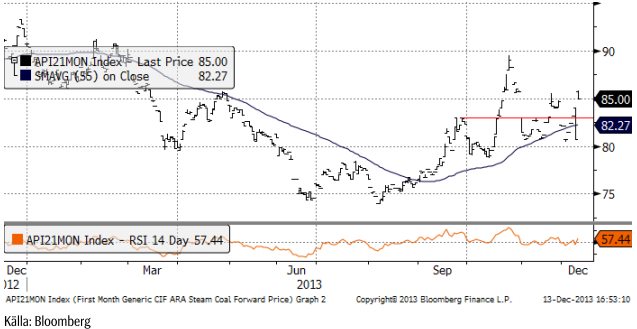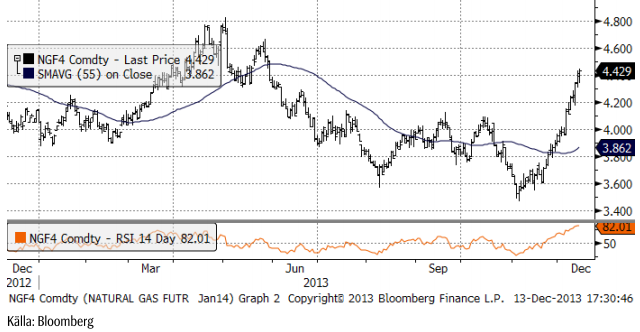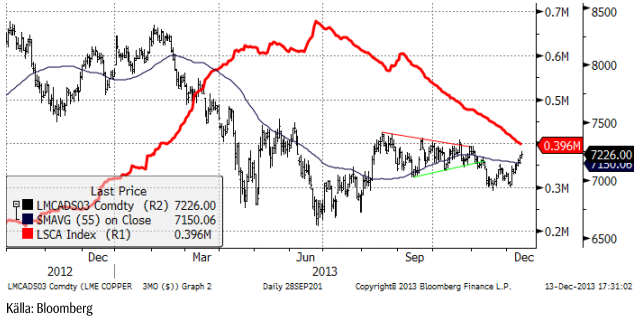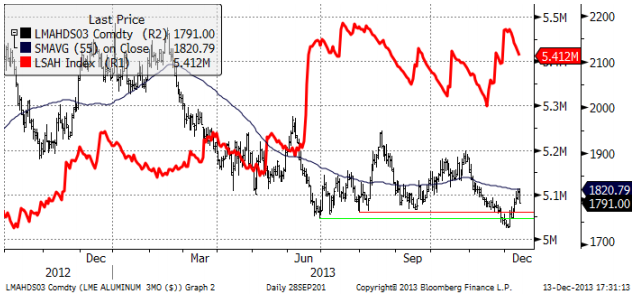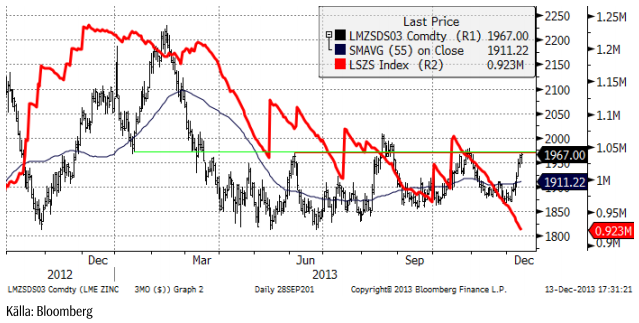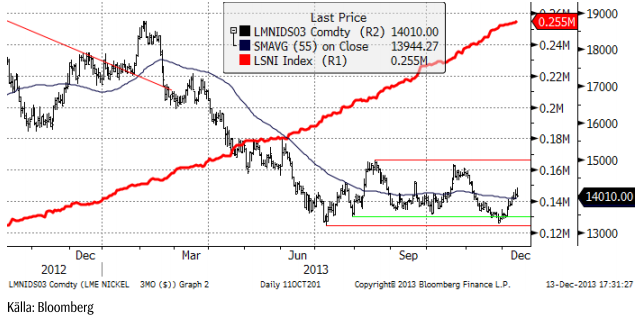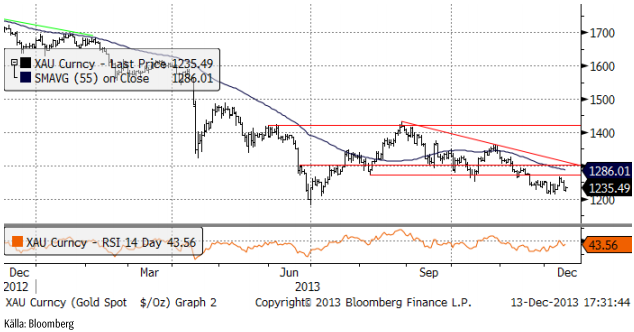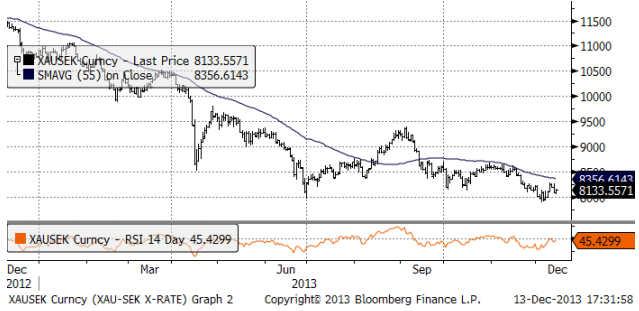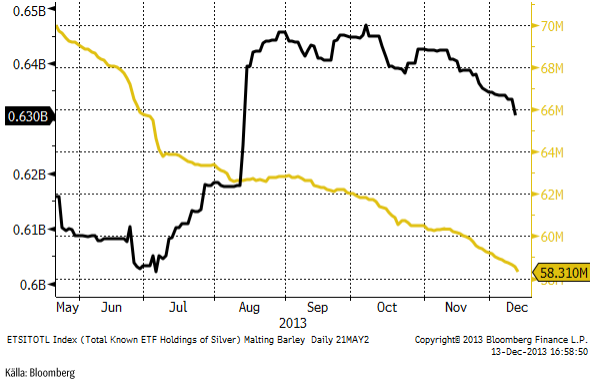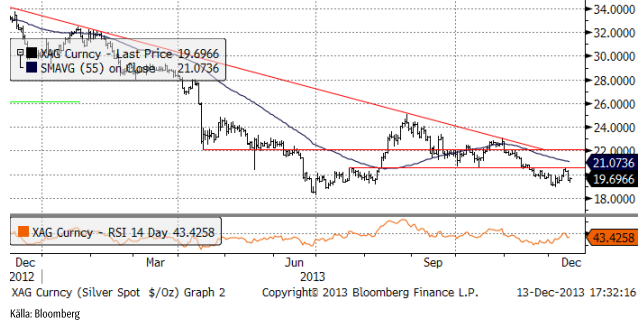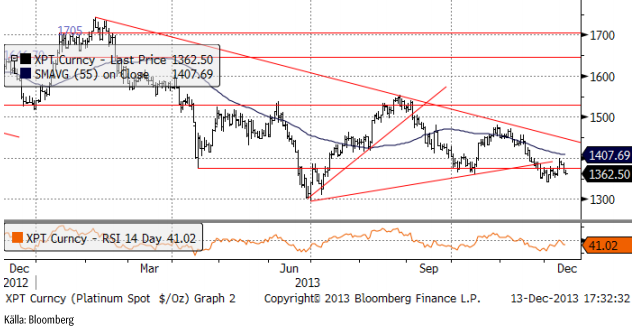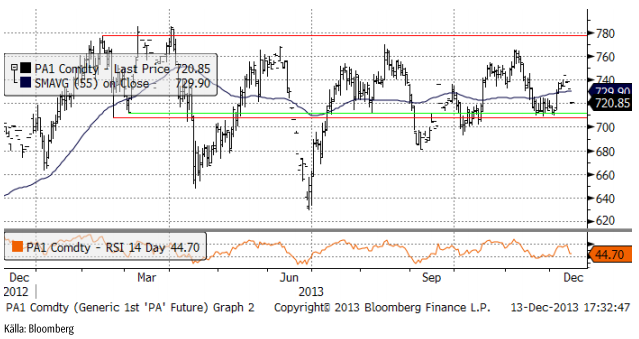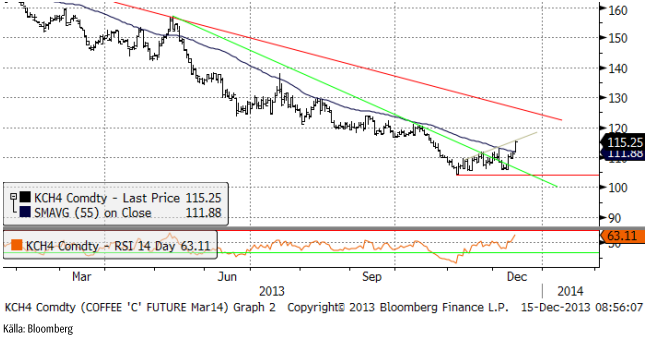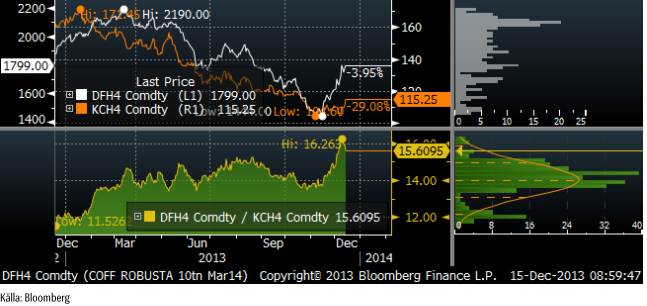Analys
SEB – Råvarukommentarer, 16 december 2013
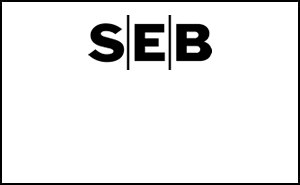
Rekommendationer
*) Avkastningen anges för 1:1 certifikaten där både BULL och 1:1 certifikat är angivna.
Allmän uppföljning och bakgrund
Olja och el föll i veckan som gick, medan amerikansk naturgas steg. Soja, majs och vete föll efter den serie av höjda produktionsestimat som kommit. Socker föll, men kaffe steg. Basmetallerna steg alla. Guld och silver rörde sig sidledes, i avvaktan på veckans FED-möte, som allt fler tror kommer att ge besked om att ”tapering” av QE inleds.
Vi har några rekommendationsändringar också. Vi går över till neutral på aluminium från den kortsiktiga köprekommendationen. Vi går över till neutral på olja från sälj och vi gör över till sälj på vete från neutral. Silver går över från neutral till en kortisktig säljrekommendation på. Kaffe går vi efter lång väntan över till köprekommendation på. Mars-terminen stängde över tidigare toppar på 115 cent i fredags och vi går över till köprekommendation med målkursen 130 cent.
Nästa veckobrev kommer ut i januari och vi önskar alla läsare en God Jul och Gott Nytt År 2014!
Råolja – Brent
Oljepriset sjönk förra veckan från 111.6 dollar till drygt 108 dollar. Den tekniska stödlinjen bröts och det borde finnas ytterligare lite till att hämta på nedsidan innan det är dags att gå ur BEAR OLJA X2 S, som vi rekommenderade förra veckan. Snart är det dags att återgå till OLJA S, som är en långsiktig position som tjänar pengar huvudsakligen på rabatten i terminsmarknaden för olja. Dock har backwardation minskat den senaste tiden och är nu endast 3% på årsbasis. Man bör alltså avvakta med köp av OLJA S.
I måndags fattade Mexikos parlament det väntade beslutet om att liberalisera och modernisera sin petroleumlagstiftning, inklusive en sänkning av produktionsskatten. Presidenten väntar sig en produktionsökning från dagens 2.5 mbpd till 3.5 mbpd inom några år, men det låter i våra öron orealistiskt.
Libyens regering har meddelat att alla landets oljehamnar ska vara öppna från och med den 15 december. Libyen producerar idag (utan alla oljehamnar i drift) 250,000 bpd. Maxproduktionen är 1.5 mbpd och det är regeringens målsättning att nå dit. Vi tror att landet visserligen kommer att göra sitt bästa, men man har inte löst några strukturella problem, det som legat bakom produktionsbortfallet. Libyen är fortfarande ett klan-samhälle, där människors lojalitet i första hand är till den egna klanen.
Iran har en ”interrim deal” med världssamfundet, men uppgörelsen måste ratificeras av USA:s kongress och av högste ledaren i Iran. Produktionen har hittills i år legat på 2.6 mbpd och exporten på 1.1 mbpd och kommer förmodligen att göra det en bit in på nästa år. USA är naturligtvis oroligt för att Iran ska producera och exportera mer, samtidigt som landet inte avvecklar sitt kärnvapenprogram. Iran var det första land som engelsmännen hittade olja i, vid början av 1900-talet. Anglo Persian var starten till det som idag är BP. Fortfarande finns stora reserver och resurser i landet.
Primus motor på efterfrågesidan, Kina, väntas öka sin oljekonsumtion med 0.5 mbpd nästa år. Samtidigt ser vi alltså att länder som Mexico, Libyen och Iran var och en för sig har potential att mätta den efterfrågeökningen, även om det inte är sannolikt att någon av dem faktiskt gör det. Men tillsammans har de goda möjligheter att göra det.
Det mest iögonfallande med Kinas ekonomi just nu är att osäkra fordringar ökar i Kinas banksystem. Det finns en risk för en krasch i Kina. Vi ser i och för sig, som nämnt ovan, att konsumtionen växer, inte minst oljekonsumtionen.
Exxon Mobile publicerade nyligen sin långsiktiga energy outlook. De är positiva till möjligheterna att kraftigt öka produktionen av olja, men fram emot 2030 tror de att OPEC-oljan återigen växer i betydelse, eftersom OPEC sitter på så stora reserver av olja. Vi noterar dock att den här prognosen inte i det avseendet skiljer sig från en mycket stor mängd tidigare prognoser om framtida produktion. Nästan alla sådana prognoser har förutspått en minskning av produktionen någonstans inne i framtiden, men det har aldrig blivit så. Ny teknik har sänkt kostnaderna och gjort tidigare olönsamma resurser till utvinningsbara reserver.
En sak som inte påverkar oljepriset, men som kommer att prägla marknaden, framförallt i Europa de närmaste åren, är en närmast total utslagning av raffinaderier i Europa. En stor del av kostnaden för ett raffinaderi är energin som går åt vid processen. USA har därvid tillgång till gas till en tredjedel av priset i Europa och billig elektricitet. För Sveriges del är detta bekymmersamt, eftersom en av Sveriges största exportprodukter är petroleumprodukter. Raffinaderierna i EU är dessutom gamla och enkla, medan de nya stora raffinaderierna i Asien är väsentligt mycket mer effektiva.
Ser vi till DOE-statistiken i veckan, ser vi att USA kom över 7000 mbp per konsumtion i november för första gången sedan 2008.
I onsdagens DOE-rapport föll råoljelagren fortsatt och ligger nu på samma nivå som för ett år sedan.
Anledningen till de lägre lagren i veckan var dock inte ökad konsumtion, utan väsentligt lägre import. Importen var på den lägsta nivån i år. Därmed var den på den lägsta nivån på åtminstone 7 år (sannolikt på mycket längre tid än så, men jag har inte kollat upp den saken).
Vi lutar fortsatt åt att det kan finnas potential för ytterligare nedgång i oljepriset, men man bör inte dra sig för att gå ur BEAR OLJA X2 S och lägga sig neutral.
Elektricitet
Elpriset klappade ihop fullständigt i veckan som gick, i en handel där få aktörer vågade köpa och andra stängde långa positioner med stor besvikelse. Vinterpremien har helt gått ur terminsmarknaden och det är ovanligt. Den enda fundamentala orsaken till prisnedgången är det oväntade omslaget i väder i det nordiska börsområdet till milt och blött.
Nedanför ser vi prognoser på avvikelsen från det normala. Till vänster är det väntad avvikelse i temperatur. Vi ser att Sverige och Norge väntas vara 4 – 6 grader varmare än normalt 22 – 30 december. Vi ser också att Finland väntas vara 6 -10 grader varmare än normalt. I kartbilden till höger ser vi nederbördens avvikelse från det normala. Vi ser att det väntas regna mycket mer än normalt i Sverige, Norge och Finland under perioden 15 december till 30 december.
Priset på nordisk el har fallit med nästan 15% i förhållande till tysk eller kontinental på en vecka. SEB har index som följer avkastningen på en investering i kvartalskontrakt på el. Indexen beräknas av NasdaqOMX. Vi ser kvoten mellan SEBCNPOW (nordiska terminer) och SEBCEPOW (kontinentala elterminer) nedan och det kraftiga fallet i veckan.
Långsiktigt ges elpriset i Norden av det tyska, kontinentala, priset på el, som i sin tur ges av marginalkostnaden för kolkraft. Priset på kol har faktiskt gått upp i veckan, liksom priset på utsläppsrätter. Utsläppsrätterna gick upp från 4.92 till 5.03 euro.
Nedan ser vi priset på energikol, den närmaste månadens leveranstermin.
Ett så kraftigt fall som vi haft på andra kvartalets terminskontrakt, kan följas av fler likadana dagar. Ett problem med positioner som tas med hänvisning till att något är ”fundamentalt” billigt, är att om priset faller, så blir det bara ”ännu billigare” och alltså ännu mer köpvärt. ”Stop loss” idén blir inte riktigt tillämpbar i sådana situationer.
Vi anser alltjämt att elpriset på ett par års sikt kommer att vara högre än det är idag, därför att det ytterst styrs av kolpriset och detta ligger under produktionskostnaden. Inget har förändrat detta och därför tycker vi egentligen att elpriset är ännu mer köpvärt idag än det var tidigare.
Men det ser fortsatt svagt ut. Vi har 2.5 gånger normal nederbörd i prognosen och 6 grader över normal temperatur över 10-dygnsprognosen. Dessutom kommer allt detta med vind – lagom stark för att vindkraften ska producera på hög kapacitet. Spotpriset, sys, är nere på 31.5, också lägre än marknadens tro i fredags. Stor utmaning för systemet kommande veckor med ”körpress” i samband med låg helgkonsumtion. Under Julhelgen kan spotpriset bli lågt, mycket lågt. Men vi vet dock att om det blir ett plötsligt väderomslag, kan prisuppgången bli plötslig och stark.
Långsiktigt tycker vi elpriset är billigt och köpvärt, men vi skulle inte köpa (mer) idag, utan vara beredd på att köpa när vädret slår om.
Vår vy är därför att EL S är rätt placering, men avvakta med köp.
Naturgas
Naturgaspriset i USA har handlats upp på det kalla vädret. Det har varit mycket kallt i USA i veckan.
Koppar
Som vi nämnde förra veckan, karaktäriseras den fysiska marknaden av stabil efterfrågan, till den grad att det finns en bristsituation på raffinerad metall för omedelbar leverans. Bristen återspeglas i frontkontrakten och har blivit ännu tydligare den här veckan på LME. 3-månaders terminer handlas med 15 dollars rabatt i förhållande till spotpriset. De flesta marknadsobservatörer gör bedömningen att detta är ett tillfälligt fenomen. De väntar sig högre produktion av raffinerad metall i framtiden.
Kinesisk produktionsstatistik publicerades i veckan. Den visade att produktionen i november låg på en ny rekordnivå. Produktionen var 28% högre än förra året, på 654 kt. Trots detta uppvisade kopparmarknaden en imponerande styrka i veckan.
Som vi nämnt tidigare, har kopparproduktionen i Indonesien kommit in i nyhetsflödet. Tidigare har fokus helt varit på nickelmalmen. Freeport McMoRan är i diskussioner med den indonesiska regeringen att “clarify the situation surrounding a ban on unprocessed raw-material exports”. Bara det faktum att den enorma Grasberg-gruvan, kan komma att omfattas av exportförbudet, kan ha bidragit till prisuppgången på koppar i veckan. Den generella uppfattningen bland marknadsaktörerna verkar dock vara att exporten (koppar och guld) från gruvan inte berörs, eftersom den arbetar under ett ”Contract of Work” (COW). De flesta andra producenter i landet arbetar under ”Local Business Licenses” (IUP).
Vi tycker att prisfallet har gett en möjlighet att komma in på den långa sidan till bra pris och rekommenderar köp av KOPPAR S.
Aluminium
Aluminium, som till skillnad från de andra basmetallerna, befinner sig prismässigt i fallande trend och inte i en konsolidering, följde med de andra metallerna uppåt på generellt täckning av korta positioner i marknaden. Handeln inleddes på 1774 dollar i måndags och nådde högsta noteringen i onsdags på 1824. Det var tillräckligt för att attrahera nya säljare. Aluminium är den metall med störst produktionsöverskott och vi är inte förvånade över marknadens bedömning. Vi tror dock att återhämtningen kan fortsätta ett par veckor till, men inte med någon styrka. Om priset faller tillbaka, kan 1750 dollar vara en stödnivå att ta fasta på.
LME-lagren har börjat minska (röd linje), med 40 kt i veckan. Annullerade warrants (lagerbevis vid LME) uppgick till 200 kt. Den allmänna uppfattningen är att detta material flyttas till andra lagerhus och alltså inte konsumeras. LME:s lagerhus är dyrare än lagerhus utanför LME. Det kan till och med vara i samma lagerlokal, men flyttad till en annan del, som inte ingår i LME:s lager. Detta lager fortsätter att hedgas med terminer på LME, där terminerna idag alltjämt erbjuder ca 7% intäkt, som ska täcka finansieringskostnad (låg) och lagerkostnad, vilket det med lätthet gör när intäkten är 7% på en metall, som aluminium.
Vi har haft kortsiktigt köp på aluminium, men går över till neutral nu.
Zink
Zinkpriset har visat imponerande styrka och priset testar nu den övre delen av prisintervallet som varit rådande sedan vårvintern. Tendensen till högre bottnar, vilket indikerar en styrka i marknaden gör att vi tror att topparna kring 2000 dollar / ton kommer att tas ut, om inte vid den här gången, så vid nästa uppgång. Zinkrpiset steg med 3.8% i veckan. Terminskurvan visar tecken på brist. Cash till tre-månders spreaden har gått från 20 dollar i contango till samma pris på en vecka. Det är ett tecken på att placerare täcker korta positioner. De köper 3-månders termin och justerar positionen i datum nära cash (spreaden blir då en ”borrow”).
Marknaden ser ut att ha gått lite för långt med nio uppgångsdagar i följd! Föregående topp på 1980 dollar kommer förmodligen att innebära en anledning för vissa att ta hem vinster. Men som nämnt ovan, finns möjligheter för ytterligare uppgång. Zink är den bästa metallen i år, då den bara gått ner med 5% sedan året började.
Som vi ser fortsätter lagren av metall vid LME att rasa (röd kurva).
Vi rekommenderar köp av ZINK S.
Nickel
Som väntat, intensifierades spekulationerna om att Indonesien verkligen ska införa sitt sedan länge beslutade förbud mot export av nickelmalm / koncentrat. Öppen balans steg också på LME, vilket kan innebära att nya terminsköpare har kommit in i marknaden. Stigande öppen balans och stigande priser innebär också vanligtvis att momentum är på köpsidan. På optionsmarknaden stiger handlade volatiliteter, vilket innebär att folk köper optioner för att skydda sig mot risken för kraftigt stigande pris på nickel. Det är en vanlig strategi att köpa optioner, istället för terminer, när det finns en asymmetri i möjliga utfall. Om det blir ett exportstopp, kan priset stiga kraftigt. Om det inte blir det, faller priset, men inte mycket. I sådana digitala situationer är det bra att vara ägare av köpoptioner, i alla fall om man kan få dem så billigt som man kunde för en vecka sedan.
Vår tolkning av marknadsläget är att marknaden inte är säker på att exportförbudet verkligen kommer att genomföras fullt ut. Om det införs, kommer det att ha en stor och avgörande påverkan. Indonesien producerar 15% av världens nickelmalm. Nickelinnehållet är 450 kt. Det här materialet är avgörande för Kinas nya lågkostnadsproducenter av Nickel Pig Iron, för rostfritt stål. Alternativet till Indonesiens lateritmalm / ferronickel, är malm från Filippinerna, som har lägre nickelhalt. 450 kt ska jämföras med överskottet i nickelmarknaden som är 50 – 100 kt på årsbasis. LME-lagret uppgår till 250 kt. Kina sägs ha 6 månaders lager av nickelmalm. Så om det blir ett totalt exportförbud, finns det lager att ta av till dess exporten av metall kommer igång, men bufferten och lagren försvinner.
Tekniskt noterar vi att stödet som bottennivån från juli höll. Det är fritt upp till 15,000 dollar per ton, den övre delen av prisintervallet som priset har handlats inom sedan sommaren.
Vi rekommenderar köp av NICKEL S.
Guld
Guldpriset (i dollar) fann stöd på samma nivå som vårens prisfall hejdades vid, alltså vid 1200 dollar per uns. Certifikatplacerare har hållit sig borta från köpsidan sedan i våras, men i veckan kom de tillbaka. Priset steg som mest upp mot det tekniska motstånd som gavs av bottennoteringarna i augusti och i oktober. Att marknaden inte orkade över den nivån, ser vi som negativt. Vi tror att marknaden kommer att vilja testa 1200 igen. Det talas om att FED eventuellt kommer att fatta beslut om ”tapering” av QE på sitt möte i veckan som kommer. Om de gör det kan det få guldpriset att falla.
I termer av kronor, är priset på guld strax över botten-noteringen. Trenden är fallande. Gissningsvis fortsätter priset att sjunka.
Finansiella placerare har fortsatt att i stadig takt överge guld som investering, som vi ser i diagrammet över ETP-ers guldinnehav. Även innehaven i silver likvideras, i veckan accelererade likvideringen av silver-ETP-er.
Priset på guld är nere på en nivå där många gruvbolag inte kan redovisa vinst långsiktigt och det gör att vi trots allt inte är beredda att gå kort, men det troliga är ändå att priset går ner ytterligare lite och risken är att FED-mötet i veckan ger en anledning att sälja på guldet.
Vi fortsätter tills vidare med neutral vy på guld.
Silver
Nedan ser vi kursdiagrammet för silver i dollar per troy ounce. Det ser faktiskt tydligt negativt ut, med en rekyl upp mot den tidigare genombrutna stödlinjen, avklarad. Vi går över till säljrekommendation, kortsiktigt. Vi tänker att målkursen kan vara 18 dollar och BEAR SIlLVER X2 S kan kanske vara att föredra med lägre risknivå än X4:an.
Vi gör alltså en kortsiktig rekommendation av BEAR SILVER X2 S – eller för den som vill ta mer risk – BEAR SILVER X4 S.
Platina & Palladium
Gruvarbetarna i NUM-facket vid Northam-gruvan röstade häromdagen om att fortsätta strejken. Dessutom fick Lonmin-anställda rätt att gå i strejk i tisdags, av den statliga medlaren. Platina-priset har trots detta fallit tillbaka. Den tekniska analysen indikerar sälj.
Tekniskt har platinapriset brutit en triangelformation på nedsidan, nu på klassiskt vis gått upp till strax under nedre delen av den triangeln och detta brukar följas av ett nytt prisfall. Enligt den tekniska analysen skulle ett test av 1300 dollar vara att vänta.
Priset på palladium föll tillbaka från uppgången till över 740 dollar och ligger nu på 720. Notera dock det starka stödet vid 710 dollar.
Vi behåller våra neutrala rekommendation på palladium och platina.
Kaffe
Kaffepriset tycks ha etablerat en botten strax över 100 cent. Det är det lägsta priset på sju år. Sedan tidigt 1970-tal har kaffepriset vänt upp från 100 cent inte mindre än sju gånger (beror lite på hur man räknar). Vi går nu över till köprekommendation, men vi ska samtidigt ha i minnet att det fortfarande råder ett produktionsöverskott i världen. De kaffebönder som reagerade på rekordpriserna för tre år sedan och planterade nya kaffebuskar, började få skörd två år efter planteringen. Kaffebuskarnas ekonomiska livslängd är ca 15 år. Kaffebönderna drar sig nog i det längsta för att byta ut dem till sockerrör, i synnerhet som det priset inte utvecklat sig så mycket bättre. Produktionskostnaden i Brasilien väntas enligt USDA uppgå till 147 cent / pund – i genomsnitt. I den här köprekommendationen tror vi dock att det är bra att ta sikte på 130 cent. Det är en nivå med tekniskt motstånd. Naturligtvis måste man utvärdera hur marknaden går, men 130 cent kan vara en bra målkurs just nu.
Vietnam håller inne med försäljning, trots att man fått en rekordskörd. Det har gjort att terminerna på robusta i London har stigit kraftigt den senaste tiden – och dragit ifrån den dyrare arabican. Robusta handlas i dollar / ton och arabican i cent / pund. I diagrammet nedan, ser vi hur spreaden mellan de två gått isär – vilket eftersom priserna hänger ihop på lång sikt – innebär att sannolikeheten är stor att spreaden går ihop igen. Dt kan i och för sig ske genom att robustan faller i pris, och inte enbart genom att arabican stiger i pris.
Vi rekommenderar alltså köp av KAFFE S, eller BULL KAFFE X4 S för den som vill ta mer risk.
För fler analyser på jordbruksråvaror se SEBs analysbrev om jordbruksråvaror.
[box]SEB Veckobrev Veckans råvarukommentar är producerat av SEB Merchant Banking och publiceras i samarbete och med tillstånd på Råvarumarknaden.se[/box]
Disclaimer
The information in this document has been compiled by SEB Merchant Banking, a division within Skandinaviska Enskilda Banken AB (publ) (“SEB”).
Opinions contained in this report represent the bank’s present opinion only and are subject to change without notice. All information contained in this report has been compiled in good faith from sources believed to be reliable. However, no representation or warranty, expressed or implied, is made with respect to the completeness or accuracy of its contents and the information is not to be relied upon as authoritative. Anyone considering taking actions based upon the content of this document is urged to base his or her investment decisions upon such investigations as he or she deems necessary. This document is being provided as information only, and no specific actions are being solicited as a result of it; to the extent permitted by law, no liability whatsoever is accepted for any direct or consequential loss arising from use of this document or its contents.
About SEB
SEB is a public company incorporated in Stockholm, Sweden, with limited liability. It is a participant at major Nordic and other European Regulated Markets and Multilateral Trading Facilities (as well as some non-European equivalent markets) for trading in financial instruments, such as markets operated by NASDAQ OMX, NYSE Euronext, London Stock Exchange, Deutsche Börse, Swiss Exchanges, Turquoise and Chi-X. SEB is authorized and regulated by Finansinspektionen in Sweden; it is authorized and subject to limited regulation by the Financial Services Authority for the conduct of designated investment business in the UK, and is subject to the provisions of relevant regulators in all other jurisdictions where SEB conducts operations. SEB Merchant Banking. All rights reserved.
Analys
Tightening fundamentals – bullish inventories from DOE

The latest weekly report from the US DOE showed a substantial drawdown across key petroleum categories, adding more upside potential to the fundamental picture.

Commercial crude inventories (excl. SPR) fell by 5.8 million barrels, bringing total inventories down to 415.1 million barrels. Now sitting 11% below the five-year seasonal norm and placed in the lowest 2015-2022 range (see picture below).
Product inventories also tightened further last week. Gasoline inventories declined by 2.1 million barrels, with reductions seen in both finished gasoline and blending components. Current gasoline levels are about 3% below the five-year average for this time of year.
Among products, the most notable move came in diesel, where inventories dropped by almost 4.1 million barrels, deepening the deficit to around 20% below seasonal norms – continuing to underscore the persistent supply tightness in diesel markets.
The only area of inventory growth was in propane/propylene, which posted a significant 5.1-million-barrel build and now stands 9% above the five-year average.
Total commercial petroleum inventories (crude plus refined products) declined by 4.2 million barrels on the week, reinforcing the overall tightening of US crude and products.


Analys
Bombs to ”ceasefire” in hours – Brent below $70

A classic case of “buy the rumor, sell the news” played out in oil markets, as Brent crude has dropped sharply – down nearly USD 10 per barrel since yesterday evening – following Iran’s retaliatory strike on a U.S. air base in Qatar. The immediate reaction was: “That was it?” The strike followed a carefully calibrated, non-escalatory playbook, avoiding direct threats to energy infrastructure or disruption of shipping through the Strait of Hormuz – thus calming worst-case fears.

After Monday morning’s sharp spike to USD 81.4 per barrel, triggered by the U.S. bombing of Iranian nuclear facilities, oil prices drifted sideways in anticipation of a potential Iranian response. That response came with advance warning and caused limited physical damage. Early this morning, both the U.S. President and Iranian state media announced a ceasefire, effectively placing a lid on the immediate conflict risk – at least for now.
As a result, Brent crude has now fallen by a total of USD 12 from Monday’s peak, currently trading around USD 69 per barrel.
Looking beyond geopolitics, the market will now shift its focus to the upcoming OPEC+ meeting in early July. Saudi Arabia’s decision to increase output earlier this year – despite falling prices – has drawn renewed attention considering recent developments. Some suggest this was a response to U.S. pressure to offset potential Iranian supply losses.
However, consensus is that the move was driven more by internal OPEC+ dynamics. After years of curbing production to support prices, Riyadh had grown frustrated with quota-busting by several members (notably Kazakhstan). With Saudi Arabia cutting up to 2 million barrels per day – roughly 2% of global supply – returns were diminishing, and the risk of losing market share was rising. The production increase is widely seen as an effort to reassert leadership and restore discipline within the group.
That said, the FT recently stated that, the Saudis remain wary of past missteps. In 2018, Riyadh ramped up output at Trump’s request ahead of Iran sanctions, only to see prices collapse when the U.S. granted broad waivers – triggering oversupply. Officials have reportedly made it clear they don’t intend to repeat that mistake.
The recent visit by President Trump to Saudi Arabia, which included agreements on AI, defense, and nuclear cooperation, suggests a broader strategic alignment. This has fueled speculation about a quiet “pump-for-politics” deal behind recent production moves.
Looking ahead, oil prices have now retraced the entire rally sparked by the June 13 Israel–Iran escalation. This retreat provides more political and policy space for both the U.S. and Saudi Arabia. Specifically, it makes it easier for Riyadh to scale back its three recent production hikes of 411,000 barrels each, potentially returning to more moderate increases of 137,000 barrels for August and September.
In short: with no major loss of Iranian supply to the market, OPEC+ – led by Saudi Arabia – no longer needs to compensate for a disruption that hasn’t materialized, especially not to please the U.S. at the cost of its own market strategy. As the Saudis themselves have signaled, they are unlikely to repeat previous mistakes.
Conclusion: With Brent now in the high USD 60s, buying oil looks fundamentally justified. The geopolitical premium has deflated, but tensions between Israel and Iran remain unresolved – and the risk of missteps and renewed escalation still lingers. In fact, even this morning, reports have emerged of renewed missile fire despite the declared “truce.” The path forward may be calmer – but it is far from stable.
Analys
A muted price reaction. Market looks relaxed, but it is still on edge waiting for what Iran will do

Brent crossed the 80-line this morning but quickly fell back assigning limited probability for Iran choosing to close the Strait of Hormuz. Brent traded in a range of USD 70.56 – 79.04/b last week as the market fluctuated between ”Iran wants a deal” and ”US is about to attack Iran”. At the end of the week though, Donald Trump managed to convince markets (and probably also Iran) that he would make a decision within two weeks. I.e. no imminent attack. Previously when when he has talked about ”making a decision within two weeks” he has often ended up doing nothing in the end. The oil market relaxed as a result and the week ended at USD 77.01/b which is just USD 6/b above the year to date average of USD 71/b.

Brent jumped to USD 81.4/b this morning, the highest since mid-January, but then quickly fell back to a current price of USD 78.2/b which is only up 1.5% versus the close on Friday. As such the market is pricing a fairly low probability that Iran will actually close the Strait of Hormuz. Probably because it will hurt Iranian oil exports as well as the global oil market.
It was however all smoke and mirrors. Deception. The US attacked Iran on Saturday. The attack involved 125 warplanes, submarines and surface warships and 14 bunker buster bombs were dropped on Iranian nuclear sites including Fordow, Natanz and Isfahan. In response the Iranian Parliament voted in support of closing the Strait of Hormuz where some 17 mb of crude and products is transported to the global market every day plus significant volumes of LNG. This is however merely an advise to the Supreme leader Ayatollah Ali Khamenei and the Supreme National Security Council which sits with the final and actual decision.
No supply of oil is lost yet. It is about the risk of Iran closing the Strait of Hormuz or not. So far not a single drop of oil supply has been lost to the global market. The price at the moment is all about the assessed risk of loss of supply. Will Iran choose to choke of the Strait of Hormuz or not? That is the big question. It would be painful for US consumers, for Donald Trump’s voter base, for the global economy but also for Iran and its population which relies on oil exports and income from selling oil out of that Strait as well. As such it is not a no-brainer choice for Iran to close the Strait for oil exports. And looking at the il price this morning it is clear that the oil market doesn’t assign a very high probability of it happening. It is however probably well within the capability of Iran to close the Strait off with rockets, mines, air-drones and possibly sea-drones. Just look at how Ukraine has been able to control and damage the Russian Black Sea fleet.
What to do about the highly enriched uranium which has gone missing? While the US and Israel can celebrate their destruction of Iranian nuclear facilities they are also scratching their heads over what to do with the lost Iranian nuclear material. Iran had 408 kg of highly enriched uranium (IAEA). Almost weapons grade. Enough for some 10 nuclear warheads. It seems to have been transported out of Fordow before the attack this weekend.
The market is still on edge. USD 80-something/b seems sensible while we wait. The oil market reaction to this weekend’s events is very muted so far. The market is still on edge awaiting what Iran will do. Because Iran will do something. But what and when? An oil price of 80-something seems like a sensible level until something do happen.
-

 Nyheter3 veckor sedan
Nyheter3 veckor sedanStor uppsida i Lappland Guldprospekterings aktie enligt analys
-

 Nyheter4 veckor sedan
Nyheter4 veckor sedanBrookfield ska bygga ett AI-datacenter på hela 750 MW i Strängnäs
-

 Nyheter4 veckor sedan
Nyheter4 veckor sedanSommaren inleds med sol och varierande elpriser
-

 Nyheter4 veckor sedan
Nyheter4 veckor sedanOPEC+ ökar oljeproduktionen trots fallande priser
-

 Nyheter3 veckor sedan
Nyheter3 veckor sedanSilverpriset släpar efter guldets utveckling, har mer uppsida
-

 Analys4 veckor sedan
Analys4 veckor sedanBrent needs to fall to USD 58/b to make cheating unprofitable for Kazakhstan
-

 Nyheter4 veckor sedan
Nyheter4 veckor sedanTradingfirman XTX Markets bygger datacenter i finska Kajana för 1 miljard euro
-

 Nyheter2 veckor sedan
Nyheter2 veckor sedanUppgången i oljepriset planade ut under helgen


